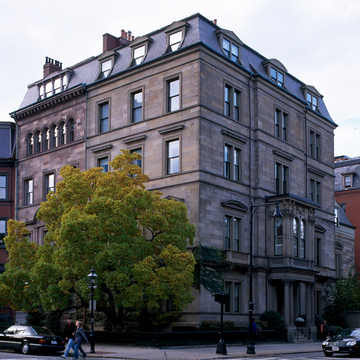Arthur Gilman's house for John D. Bates represents a perpetuation of his Parisian formula in a larger residence that appears as a freestanding block from the front. Adjacent on Commonwealth Avenue, Edward C. Cabot designed a small house at number 1 that was one of the earliest to express an individuality in the exterior design which clearly distinguished the Back Bay from Paris. Incorporated internally with the John Bates House in 1893, the Samuel Ward House was designed to be harmonious yet distinct from its neighbor. Cabot, one the architects of the Boston Athenaeum (BH7) in 1846–1849, chose to unite the Commonwealth Avenue facades of the Bates and Ward houses with identical roof and cornice lines (removed on the Bates House), but he introduced his own fenestration patterns. On the fourth floor Cabot placed a cluster of six round-arched windows and for the piano nobile, a bold, arched composition that clearly distinguished this small house from its Second Empire–style neighbors.
You are here
John D. Bates House and Samuel Ward House
If SAH Archipedia has been useful to you, please consider supporting it.
SAH Archipedia tells the story of the United States through its buildings, landscapes, and cities. This freely available resource empowers the public with authoritative knowledge that deepens their understanding and appreciation of the built environment. But the Society of Architectural Historians, which created SAH Archipedia with University of Virginia Press, needs your support to maintain the high-caliber research, writing, photography, cartography, editing, design, and programming that make SAH Archipedia a trusted online resource available to all who value the history of place, heritage tourism, and learning.

